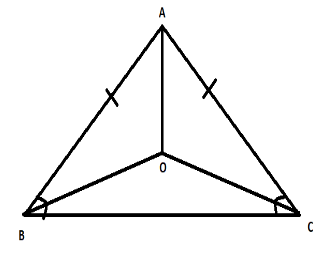
In an isosceles triangle, \[ABC\] , with \[AB = AC\] the bisectors of \[\angle B\] and \[\angle C\] intersect at each other. Join \[A\] to \[O\]. Show that:
i) \[OB = OC\]
ii) \[AO\] bisects \[\angle A\]
Answer
505.8k+ views
Hint: The given question is based on an isosceles triangle. An isosceles triangle is a triangle with (at least) two equal sides. In this question we want to draw an isosceles triangle by the given properties and want to prove that \[OB = OC\] and \[AO\] bisects \[\angle A\].
Complete step by step solution:
In this problem,
In an isosceles triangle, \[ABC\] , with \[AB = AC\] the bisectors of \[\angle B\] and \[\angle C\] intersect at each other. Join \[A\] to \[O\].
Here, we need to show that,
(i) \[OB = OC\]
Let us draw an isosceles triangle \[ABC\],

Given,
In \[\Delta ABC\], we have
\[AB = AC\]
\[OB\]is the bisector of \[\angle B\]
So, \[\angle ABO = \angle OBC = \dfrac{1}{2}\angle B\] ………………………………. (1)
\[OC\] is the bisector of \[\angle C\]
So,\[\angle ACO = \angle OCB = \dfrac{1}{2}\angle C\] …………………………………. (2)
To prove: \[OB = OC\]
Proof:
Given , \[AB = AC\]
Angles opposite to equal sides are equal
\[\angle ACB = \angle ABC\]
\[\dfrac{1}{2}\angle ACB = \dfrac{1}{2}\angle ABC\]
By equation (1) and (2), we get
\[\angle OCB = \angle OBC\]
Hence,
Sides opposite to equal angles are equal,
\[OB = OC\]
Hence proved.
(ii) \[AO\] bisects \[\angle A\]
To prove: \[AO\] bisects \[\angle A\]
i.e., \[\angle OAB = \angle OAC\]
Proof:
We already proved that \[OB = OC\]
Also in \[\Delta ABC\] and \[\Delta ACO\]we have,
Given, \[AB = AC\] (given)
\[AO = AO\] (common)
From the equation (1) \[OB = OC\]
Therefore, by SAS (Side Angle Side) Congruence rule,
\[\Delta ABO \cong \Delta ACO\]
Since corresponding parts of congruent triangles are equal,
\[\angle OAB = \angle OAC\]
\[AO\] bisects \[\angle A\]
Hence proved.
Note:
1) An isosceles triangle therefore has both two equal sides and two equal angles.
2) Angles opposite to equal sides are equal.
3) Sides opposite to equal angles are equal.
4) If any two sides and angle included between the sides of one triangle are equivalent to the corresponding two sides and the angle between the sides of the second triangle, then the two triangles are said to be congruent by SAS rule.
5) Two triangles are congruent if their corresponding sides are equal in length, and their corresponding angles are equal in measure.
Complete step by step solution:
In this problem,
In an isosceles triangle, \[ABC\] , with \[AB = AC\] the bisectors of \[\angle B\] and \[\angle C\] intersect at each other. Join \[A\] to \[O\].
Here, we need to show that,
(i) \[OB = OC\]
Let us draw an isosceles triangle \[ABC\],

Given,
In \[\Delta ABC\], we have
\[AB = AC\]
\[OB\]is the bisector of \[\angle B\]
So, \[\angle ABO = \angle OBC = \dfrac{1}{2}\angle B\] ………………………………. (1)
\[OC\] is the bisector of \[\angle C\]
So,\[\angle ACO = \angle OCB = \dfrac{1}{2}\angle C\] …………………………………. (2)
To prove: \[OB = OC\]
Proof:
Given , \[AB = AC\]
Angles opposite to equal sides are equal
\[\angle ACB = \angle ABC\]
\[\dfrac{1}{2}\angle ACB = \dfrac{1}{2}\angle ABC\]
By equation (1) and (2), we get
\[\angle OCB = \angle OBC\]
Hence,
Sides opposite to equal angles are equal,
\[OB = OC\]
Hence proved.
(ii) \[AO\] bisects \[\angle A\]
To prove: \[AO\] bisects \[\angle A\]
i.e., \[\angle OAB = \angle OAC\]
Proof:
We already proved that \[OB = OC\]
Also in \[\Delta ABC\] and \[\Delta ACO\]we have,
Given, \[AB = AC\] (given)
\[AO = AO\] (common)
From the equation (1) \[OB = OC\]
Therefore, by SAS (Side Angle Side) Congruence rule,
\[\Delta ABO \cong \Delta ACO\]
Since corresponding parts of congruent triangles are equal,
\[\angle OAB = \angle OAC\]
\[AO\] bisects \[\angle A\]
Hence proved.
Note:
1) An isosceles triangle therefore has both two equal sides and two equal angles.
2) Angles opposite to equal sides are equal.
3) Sides opposite to equal angles are equal.
4) If any two sides and angle included between the sides of one triangle are equivalent to the corresponding two sides and the angle between the sides of the second triangle, then the two triangles are said to be congruent by SAS rule.
5) Two triangles are congruent if their corresponding sides are equal in length, and their corresponding angles are equal in measure.
Recently Updated Pages
Master Class 9 General Knowledge: Engaging Questions & Answers for Success

Master Class 9 English: Engaging Questions & Answers for Success

Master Class 9 Science: Engaging Questions & Answers for Success

Class 9 Question and Answer - Your Ultimate Solutions Guide

Master Class 12 Economics: Engaging Questions & Answers for Success

Master Class 12 Maths: Engaging Questions & Answers for Success

Trending doubts
Which places in India experience sunrise first and class 9 social science CBSE

Fill the blanks with the suitable prepositions 1 The class 9 english CBSE

Write the 6 fundamental rights of India and explain in detail

Difference Between Plant Cell and Animal Cell

What is pollution? How many types of pollution? Define it

What is the Full Form of ISI and RAW




